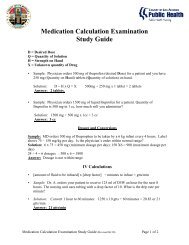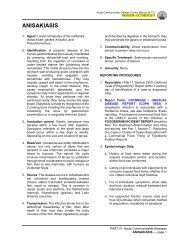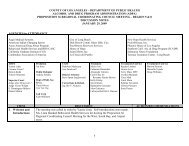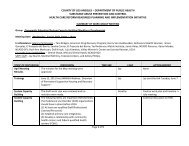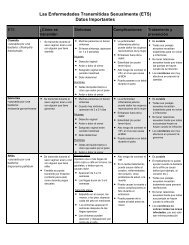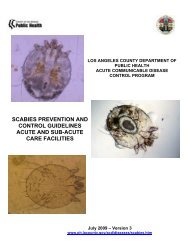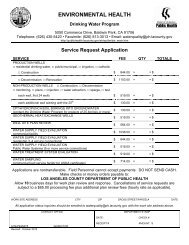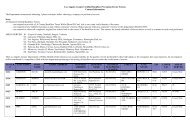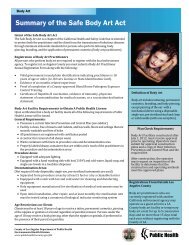Scabies Management - Department of Public Health - Los Angeles ...
Scabies Management - Department of Public Health - Los Angeles ...
Scabies Management - Department of Public Health - Los Angeles ...
You also want an ePaper? Increase the reach of your titles
YUMPU automatically turns print PDFs into web optimized ePapers that Google loves.
Sugathan Paramoo, MD<br />
<strong>Scabies</strong> <strong>Management</strong><br />
<strong>Los</strong> <strong>Angeles</strong> County<br />
<strong>Department</strong> <strong>of</strong> <strong>Public</strong> <strong>Health</strong>
What is <strong>Scabies</strong>?<br />
• <strong>Scabies</strong> is an infection <strong>of</strong> the skin caused<br />
by the human itch mite, Sarcoptes scabiei<br />
http://www.dpd.cdc.gov/dpdx/HTML/ImageLibrary/<strong>Scabies</strong>_il.htm http://www.dpd.cdc.gov/dpdx/HTML/ImageLibrary/<strong>Scabies</strong>_il.htm
Types <strong>of</strong> <strong>Scabies</strong><br />
• Typical (Conventional): Patients usually<br />
have only 10-15 live adult females on the<br />
body at any given time<br />
• Atypical (Crusted, formerly known as<br />
Norwegian): Heavy infestation with<br />
hundreds to thousands <strong>of</strong> mites. Caused<br />
when treatment & diagnosis is delayed.<br />
Highly communicable!
The Life Cycle <strong>of</strong> <strong>Scabies</strong><br />
1. Adult pregnant female mite transfers to the<br />
skin <strong>of</strong> an un-infested person<br />
2. Mite travels the skin surface at rate <strong>of</strong> 1”/min<br />
seeking a burrow site. It deposits 2-3 eggs<br />
daily<br />
3. Egg larva nymph adults in 10-17 days<br />
4. The adults migrate to the skin surface and<br />
mate. The male dies quickly & female<br />
penetrates the skin to repeat the cycle
The Life Cycle <strong>of</strong> <strong>Scabies</strong> (2)<br />
http://www.dpd.cdc.gov/dpdx/HTML/<strong>Scabies</strong>.htm
<strong>Scabies</strong> Facts<br />
• On the body, a scabies mite can live up to<br />
4-6 weeks<br />
• Once away from the human body, mites<br />
do not survive more than 48 – 72 hours<br />
• <strong>Scabies</strong> cannot jump<br />
• Visible by magnifying glass & microscope
How is <strong>Scabies</strong> Spread?<br />
• By direct, prolonged, skin-to-skin contact<br />
with a person infested with scabies (ex.<br />
bathing, back rubs, & applying lotion)<br />
• By indirect contact, sharing clothing,<br />
towels, and bedding
Incubation Period<br />
When do first symptoms appear?<br />
• Symptoms may appear 4-6 weeks after<br />
exposure to an infested person or environmental<br />
contacts (clothing, bedding, etc.) in primary<br />
infestation<br />
• If previously infested with scabies or following<br />
exposure to Atypical scabies, symptoms may<br />
appear within 1-4 days
<strong>Scabies</strong> Symptoms<br />
• Rash (small red bumps)<br />
• Papules (pimple-like rash)<br />
• Vesicle (blister-like rash)<br />
• Intense itching, especially at night and over most<br />
<strong>of</strong> the body<br />
• Rash & itching are caused by a hypersensitivity<br />
reaction (allergic response) to the mite, eggs, &<br />
feces<br />
• Burrows/tunnels (may look brown or black)<br />
• Track marks (thin threat-like lines)
<strong>Scabies</strong> Symptoms (2)<br />
• Scaly skin (flakes)<br />
• Chafed skin (irritation caused by friction)<br />
• Swollen skin<br />
• Crusty (scabs) or toughened skin<br />
• Sores on the body caused by scratching<br />
• Secondary bacterial infections or scarring<br />
caused by scratching
• Wrists<br />
Common Infection Sites<br />
• Finger webs<br />
• Elbows<br />
• Skin folds<br />
• Under breasts<br />
• Waistline<br />
• Lower abdomen<br />
• Genitals<br />
• Buttocks
http://www.dpd.cdc.gov/dpdx/HTML/<strong>Scabies</strong>.htm<br />
Skin Assessment
Typical <strong>Scabies</strong> Infestation<br />
Hand<br />
Lyna.edublogs.org
Hand<br />
http://www.lib.uiowa.edu/HARDIN/MD/cdc/scabies.html
Finger webs<br />
http://www.lib.uiowa.edu/haRDIN/MD/dermnet/scabies6.html<br />
http://www.lib.uiowa.edu/hardin/MD/dermnet/scabies11.html<br />
Wrist
http://www.dermnet.com/<strong>Scabies</strong>/picture/13248<br />
www.dermnetnz.org/arthropods/scabies.htmlwww.dermnetnz.org<br />
Wrist<br />
Arm pit
Buttocks<br />
http://www.dermnet.com/<strong>Scabies</strong>/picture/13250
http://www.dermnet.com/<strong>Scabies</strong>/picture/13164<br />
Track marks<br />
Burrows<br />
http://www.dermnet.com/<strong>Scabies</strong>/picture/13171
http://www.dermnet.com/<strong>Scabies</strong>/picture/13089<br />
Back<br />
Scrotum<br />
http://www.dermnet.com/<strong>Scabies</strong>/picture/13142
Atypical <strong>Scabies</strong> (Crusted)<br />
Mandell GL, Bennett JE, Dolin R. (2005) Principals and practice <strong>of</strong><br />
infectious disease. Sixth Edition.
Diagnosis <strong>of</strong> <strong>Scabies</strong><br />
• Often misdiagnosed<br />
• Clinical evaluation: Clinical signs and<br />
symptoms<br />
• Skin scraping: Microscopic demonstration <strong>of</strong><br />
the mite, ova, or fecal matter obtained from a<br />
skin scraping<br />
• A negative skin scraping from does not rule<br />
out scabies infestation
Who should be treated for<br />
<strong>Scabies</strong>?<br />
• Anyone diagnosed with scabies<br />
• Persons who have close, prolonged contact with<br />
the infested person should also be treated:<br />
-Patients -Household members<br />
-Employees -Co-workers<br />
-Sexual partners -Friends<br />
• Everyone should receive treatment at the same<br />
time to prevent re-infestation
<strong>Scabies</strong> Treatment Options<br />
• Topical Scabicide<br />
(most frequent)<br />
– 5% Permethrin cream<br />
(Elimite, Acticin)<br />
– 10% crotamiton lotion<br />
(Eurax)
<strong>Scabies</strong> Treatment Options (2)<br />
• Oral anti-parasitic<br />
agent<br />
– Ivermectin (Mectizan<br />
or Stromectol)<br />
– Often prescribed but<br />
not currently approved<br />
by FDA for scabies<br />
treatment
Scabicide Application<br />
• Bathe or shower, dry skin<br />
thoroughly before applying<br />
scabicide<br />
• Medication should be massaged into the skin<br />
from below the chin to the soles <strong>of</strong> the feet<br />
• Fingernails & toenails should be clipped &<br />
scabicide applied under nails<br />
• In infants, toddlers, the elderly & the<br />
immunocompromised, the head (forehead,<br />
temples and scalp) require application <strong>of</strong><br />
scabicide
Scabicide Application (2)<br />
• Contact with the eyes and mouth should be<br />
avoided<br />
• If scabicide is washed <strong>of</strong>f during hand washing,<br />
toileting or perineal care, it must be reapplied to<br />
that area<br />
• Apply medication to the skin and wash <strong>of</strong>f after<br />
8-14 hours (can be applied at bedtime and<br />
washed <strong>of</strong>f in the morning)<br />
• Itching may persist for 1-2 weeks following<br />
successful treatment
<strong>Health</strong> Care Workers<br />
Symptomatic HCWs:<br />
• Must report symptoms consistent with scabies<br />
to employer IMMEDIATELY<br />
• Must be removed from work and referred to<br />
employee health<br />
• Can return to work as soon as treatment is<br />
completed but should use gowns and gloves<br />
for direct patient care to prevent re-infestation
Isolation & Environmental Control<br />
Measures<br />
• Contact isolation during treatment period<br />
• HCWs must wear gloves & long-sleeved gowns<br />
for hands-on contact. Wash hands after removal<br />
<strong>of</strong> gloves<br />
• Washable items such as bed linens, towels &<br />
clothing, etc., used during the 72 hrs prior to<br />
treatment must be washed<br />
• Keep laundry in a plastic bag inside patient’s<br />
room, sorted & handled by gloved & gowned<br />
laundry worker, and washed in hot water for at<br />
least 10 minutes
Isolation & Environmental Control<br />
Measures (2)<br />
• Non-washable items MUST be placed in tightly<br />
sealed plastic bags for 7 days<br />
• Change all bed linens, towels & clothes daily<br />
• Disinfect multiple patient-used items (walking belts,<br />
wheelchairs, blood pressure cuffs, etc.)<br />
• Vacuum mattresses, upholstered<br />
furniture & carpeting<br />
• Routine disinfection procedures<br />
are adequate
Guidelines<br />
<strong>Los</strong> <strong>Angeles</strong> County <strong>Department</strong> <strong>of</strong> <strong>Public</strong> <strong>Health</strong><br />
Acute Communicable Disease Control Program<br />
<strong>Scabies</strong> Prevention and Control Guidelines<br />
Acute and Sub-Acute Care Facilities<br />
July 2009 – Version 3
Questions??
Acknowledgements<br />
Thank you to Paula Marin, RN,BSN for<br />
the development <strong>of</strong> this presentation<br />
Revised by:<br />
Lorraine Sisneros, RN, MPH<br />
L’Tanya English, RN, MPH<br />
Patricia Marquez, MPH



